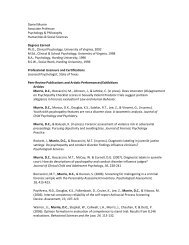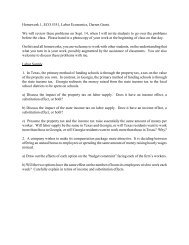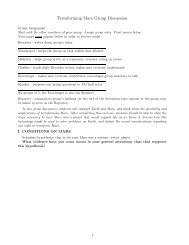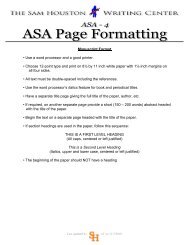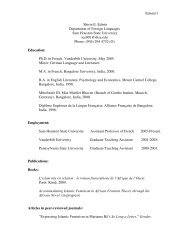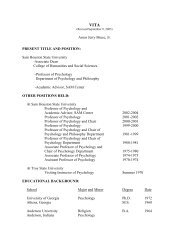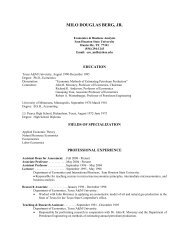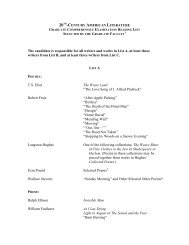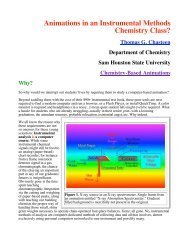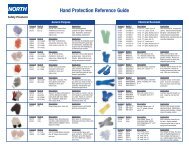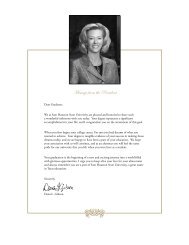Lab Spill Response Procedures and Spill Response Kit
Lab Spill Response Procedures and Spill Response Kit
Lab Spill Response Procedures and Spill Response Kit
Create successful ePaper yourself
Turn your PDF publications into a flip-book with our unique Google optimized e-Paper software.
Introduction<br />
<strong>Lab</strong> <strong>Spill</strong> <strong>Response</strong> <strong>Procedures</strong> <strong>and</strong> <strong>Spill</strong> <strong>Response</strong> <strong>Kit</strong><br />
2.<br />
What <strong>Spill</strong>s Can Be H<strong>and</strong>led By <strong>Lab</strong>oratory<br />
Personnel<br />
3. <strong>Spill</strong> Clean Up <strong>Procedures</strong><br />
4. <strong>Spill</strong> <strong>Kit</strong> Equipment<br />
The <strong>Lab</strong>oratory Chemical <strong>Spill</strong> Clean Up <strong>Procedures</strong> were created to give researchers <strong>and</strong><br />
laboratory personnel a starting point for developing a chemical spill kit <strong>and</strong> providing<br />
guidance for cleaning up chemical spills. Chemical spills <strong>and</strong> accidents need to be minimized<br />
as much as possible. If a chemical spill should occur, a quick response with a stocked<br />
chemical spill kit will help minimize potential harm to personnel, equipment <strong>and</strong> laboratory<br />
space. Outlined in Table 2, is the minimal equipment required for a spill kit. You may add<br />
equipment to the kit, provided all personnel are proficient in its use. An example would be<br />
adding a metallic mercury spill kit.<br />
Note that the majority of chemical spills can be prevented or minimized by:<br />
1. Maintaining a neat <strong>and</strong> organized work area;<br />
2. Performing a laboratory procedure review prior to conducting new experimental<br />
procedures;<br />
3. Storing liquid chemicals in secondary containment bins;<br />
4. Keeping reagent chemical containers sealed or closed at all times, except when<br />
removing contents;<br />
5. Ordering reagent chemicals in plastic or plastic coated glass containers whenever<br />
possible;<br />
6. Using secondary containment to store <strong>and</strong> move chemicals.<br />
Types of <strong>Spill</strong>s that Can Be H<strong>and</strong>led by <strong>Lab</strong>oratory Personnel<br />
<strong>Lab</strong>oratory personnel can clean up the majority of chemical spills that occur in the lab. Due<br />
to the hazardous properties of certain chemicals or size of the spill, assistance from<br />
Huntsville Fire Department (HFD) may be necessary. The following table contains a list of<br />
chemical classes with examples that might require assistance from HFD.<br />
Chemical Class Example<br />
Strong Acids - Any acid that is concentrated enough to fume or emit<br />
acid gases<br />
Strong Bases - Any base that is concentrated enough to emit vapors<br />
Poison by Inhalation - Any chemical that readily emits vapors / gases<br />
at normal temperature <strong>and</strong> pressure that are extremely toxic by<br />
inhalation<br />
Fuming Sulfuric<br />
Acid<br />
Red Nitric Acid<br />
Hydrofluoric Acid<br />
Perchloric Acid<br />
Ammonium<br />
Hydroxide<br />
Phosphorous<br />
Oxychloride<br />
Titanium<br />
Tetrachloride<br />
Formates<br />
Isocyanates
<strong>Lab</strong> <strong>Spill</strong> <strong>Response</strong> <strong>Procedures</strong> <strong>and</strong> <strong>Spill</strong> <strong>Response</strong> <strong>Kit</strong><br />
Reactive - Any chemical that is sensitive to air, water, shock, friction<br />
<strong>and</strong>/or temperature<br />
Mercury - Any mercury compound<br />
Extremely Toxic - Any chemical that is readily absorbed through the<br />
skin <strong>and</strong> is extremely toxic at small concentrations<br />
Dry Picric Acid<br />
Lithium Aluminum<br />
hydride<br />
Sodium<br />
Borohydride<br />
Phosphorus Metal<br />
Organic Peroxides<br />
Metallic Mercury<br />
Mercury Salts<br />
Aqueous Mercury<br />
Solutions<br />
Benzene<br />
Sodium Cyanide<br />
Minor spills do not necessarily need the outside assistance. <strong>Lab</strong>oratory workers who have<br />
had the proper training <strong>and</strong> possess the appropriate equipment can safely <strong>and</strong> effectively<br />
h<strong>and</strong>le the majority of chemical spills that occur in the laboratory. In addition, spills<br />
involving multiple chemicals may pose various hazards.<br />
Except for the chemical classes in Table I, labs can h<strong>and</strong>le spills involving one liter or less of<br />
liquid <strong>and</strong> one pound or less of a solid. If the spill is large, contact UPD to request assistance<br />
from HFD with the clean up. The following procedures are specific guidelines for using the<br />
recommended spill clean up materials.<br />
General <strong>Spill</strong> Clean up <strong>Procedures</strong><br />
In the event of a chemical spill, first decide if you are trained, knowledgeable <strong>and</strong> equipped<br />
to h<strong>and</strong>le the incident. Immediately evacuate the lab <strong>and</strong> notify UPD if there is a<br />
possibility of an acute respiratory hazard present or if you need assistance to<br />
clean up the spill. Never proceed to clean up a spill if you do not know the hazards<br />
associated with the chemical or if you are unsure of how to clean up the spill. If<br />
anyone is injured or contaminated, immediately notify UPD <strong>and</strong> begin<br />
decontamination measures or first aid, if trained.<br />
Don the personal protective equipment from the spill kit; splash goggles <strong>and</strong> nitrile/Silver<br />
Shield combination gloves. Always ask a fellow researcher for assistance. They should also<br />
don splash goggles <strong>and</strong> nitrile/Silver Shield combination gloves. Make sure that all forms of<br />
local exhaust, i.e. fume hoods, are operating. It is normally not advisable to open the<br />
windows. If broken glass is involved, do not pick it up with your gloved h<strong>and</strong>s. Use the<br />
scoop or tongs to place it in the bag, then place the bag in a strong cardboard box or plastic<br />
container. Follow the procedures provided below based on the class <strong>and</strong> type of chemical.<br />
All tools used in the clean up need to be decontaminated (plastic scoop, tongs, etc.).<br />
Remove all gross contamination with a wet paper towel. Dispose of the contaminated paper<br />
towels as hazardous waste. Rinse the tools off with copious amounts of water. Dispose of<br />
the gloves as hazardous waste. Dry the tools off <strong>and</strong> place back into the spill kit along with<br />
the splash goggles.<br />
Liquid <strong>Spill</strong>s other than flammable liquids<br />
Spread the chemical spill powder over the spill starting with the edges first. This will help to<br />
confine the spill to a smaller area. Spread enough powder over the spill to completely cover<br />
the liquid. There should be no free liquid. Use plastic scoop to ensure that the liquid was<br />
completely absorbed by the powder. Pick up the powder with scoop <strong>and</strong> place in the<br />
polyethylene bag. Wipe the area down with a wet paper towel. Dispose of paper towel with
<strong>Lab</strong> <strong>Spill</strong> <strong>Response</strong> <strong>Procedures</strong> <strong>and</strong> <strong>Spill</strong> <strong>Response</strong> <strong>Kit</strong><br />
the hazardous waste generated from the spill clean up. Seal bag with tape <strong>and</strong> attach a<br />
completed orange hazardous waste sticker on the bag.<br />
Flammable Liquid <strong>Spill</strong>s<br />
Control all sources of ignition. Lay the chemical spill pads over the spill. These pads are<br />
design to suppress the vapors emitted by a volatile liquid. Allow pads to completely soak up<br />
liquid. Pick up pads with tongs or other device that minimizes direct contact with a gloved<br />
h<strong>and</strong>. Place in the polyethylene bag. Wipe the area down with a wet paper towel. Dispose of<br />
paper towel with the hazardous waste generated from the spill clean up. Seal bag with tape<br />
<strong>and</strong> attach a completed hazardous waste tag to the bag.<br />
Solid <strong>Spill</strong>s<br />
Use the plastic scoop to place the spilled material into the polyethylene bag. Care should be<br />
taken so as not to create dust or cause the contaminated powder to become airborne. After<br />
the bulk of the material is cleaned up, wet a spill pad <strong>and</strong> wipe the area down. Place the<br />
pads into the polyethylene bag. Wipe the area down with a wet paper towel. Dispose of<br />
paper towel with the hazardous waste generated from the spill clean up. Seal bag with tape<br />
<strong>and</strong> attach a completed hazardous waste tag to the bag.<br />
Note: Precautions must be taken to minimize exposure to the spilled chemical. Be careful<br />
not to step in the spilled material <strong>and</strong> track it around.<br />
Table 2: Chemical <strong>Spill</strong> <strong>Kit</strong> Minimal Requirements<br />
Universal Chemical Absorbent Pads<br />
• High Capacity<br />
• Chemically Inert<br />
• Absorbs aggressive chemicals as well as non-aggressive compounds such as water<br />
• Good for all chemicals<br />
• Acids, including Hydrofluoric<br />
• Bases<br />
• Flammable Liquids<br />
• Formaldehyde<br />
• Organic Peroxides<br />
• High Capacity<br />
• Chemically Inert<br />
Universal Chemical Absorbent Powder<br />
• Absorbs aggressive chemicals as well as non-aggressive compounds such as water<br />
• Good for all chemicals<br />
• Acids, including Hydrofluoric<br />
• Bases
• Anti-Static<br />
<strong>Lab</strong> <strong>Spill</strong> <strong>Response</strong> <strong>Procedures</strong> <strong>and</strong> <strong>Spill</strong> <strong>Response</strong> <strong>Kit</strong><br />
• Flammable Liquids<br />
• Formaldehyde<br />
• Organic Peroxides<br />
• Polypropylene Plastic<br />
• Strong Construction<br />
• Leak Proof<br />
• At least 7-gallon capacity<br />
• 4mm in thickness<br />
• 0.011 thick Nitrile Gloves<br />
• At least two pairs<br />
• At least two pairs<br />
Plastic Scoop<br />
Polyethylene Bags<br />
Nitrile/Silver Shield Combination Gloves<br />
Chemical Splash Goggles<br />
Hazardous Waste Tags<br />
• Refer to Hazardous Waste Program for proper disposal



